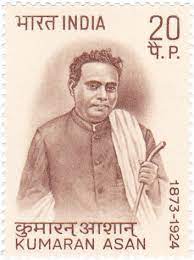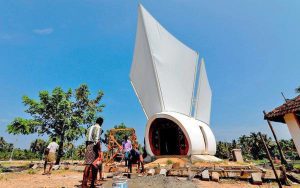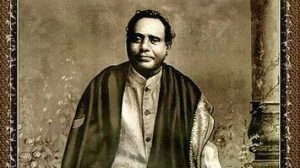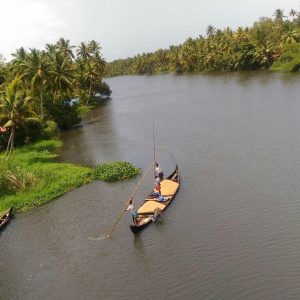Kerala commemorates the 100th anniversary of the Redeemer boat tragedy, which killed refomist poet Kumaran Asan, along with 34 others.

Kumaran Asan. (Supplied)
When a boat with the curious name Redeemer, carrying 145 people, including the crew, capsized in the Pallana river in Kerala’s present-day Alappuzha district a hundred years ago, Malayalam newspapers at the time were unfamiliar with the inverted pyramid style of reporting, in which the most important information is presented first.
So, they dutifully reported the tragedy in which 35 people died, while the rest of the passengers swam back to safety.
The last paragraphs of the reports mentioned one of the deceased as N Kumaran Asan — the celebrated Malayalam poet and the general secretary of the Sree Narayana Dharma Paripalana Yogam (SNDP), a socio-cultural organisation to which the whole of Kerala is indebted for its exceptional reformist legacy.
On Tuesday, 16 January 2024, Kerala commemorates the centenary of the passing of the towering figure who presided over social transformations during a crucial period, under the guidance of his mentor and legendary leader, Sree Narayana Guru, in addition to enriching the Malayalam language and literature as one of the triumvirate poets who brought in a new sense of aesthetics.

Kumaran Asan memorial stamp. (Supplied)
For Malayalam, Asan is the lone poet occupying the top slot of Mahakavi without writing any poem of long format.
The centenary saw people of different walks of life recalling how the modernist poet contributed significantly to ending caste-based oppressions, apart from laying the foundations for a progressive civil society where equality mattered.
Asan is the still the most widely read Malayalam poet who transformed the literary segment from the metaphysical to the lyrical. His works still win critical acclaim for their poetic concentration and dramatic contextualization, apart from their moral and spiritual content.
Marking the centenary, Kerala’s veteran director KP Kumaran is releasing his biopic Gramavrikshathile Kuyil, which delves deep into some of the unknown aspects of the illustrious life of the activist poet, who celebrated the concepts of love and dignity.
Sivagiri Mutt, the seat of Narayana Guru, has also initiated a year-long observation of the centenary of his demise with seminars and programmes evaluating how he deeply influenced present-day Kerala and its progressiveness.
The state government is also organising events to remember the revolutionary poet who died young, at 50. Asan started writing poetry when he was 16 years old, and his biographers confirm that he drew inspiration from the surrounding natural beauty at the time.
He wrote eloquently about the hills, rivers, and forests of the then-princely state of Travancore, to which he belonged. But by the time he wrote his famous Chandalabhikshuki, which can be roughly translated as an Untouchable Beggar Woman, his poetry had become a reflection of the grim social realities around him. The lengthy poem is about a woman who suffers unfair treatment due to her low social status.
Asan said he wrote this poem to raise awareness about the injustices faced by untouchables across India from caste Hindus.
It’s quite ironic that Hindutva organisations are now attempting to usurp his reformist legacy and even trying to give an anti-Muslim tilt to his death in the boat tragedy to create the wrong impression that he was a champion of early versions of resurgent Hindutva.
A strong and passionate advocate of Buddhism, Asan always remained vocal about the coexistence of people from different communities, and he was against dividing people on communal grounds. In addition to his poetry and social reformation activities, Asan had tirelessly worked to improve the education and healthcare of the people of Travancore and was a strong advocate for women’s rights.
Born on 12 April 1873, at Kayikkara near Chirayinkeezhu in Thiruvananthapuram, Asan was a member of the Travancore Legislative Council. The turning point in his life was in 1891 when he met Narayana Guru. Per the Guru’s advice, he completed his higher studies in then Bangalore and Calcutta.

The Kumaran Asan Memorial at Kumarakodi near Pallana in Kerala’s Alappuzha. (Supplied)
In 1921, he started a printing press and publishing house named Sarada Books and began a tile manufacturing unit at Aluva near Kochi. He was the first secretary of SNDP Yogam after its launch in 1903. He had also worked as the editor of Vivekodayam, the mouthpiece of SNDP.
Even though he had not written any poems of long format, Madras University accorded him the title Mahakavi in recognition of the new aesthetic sensibility he infused into Malayalam literature in 1922. The spot where Asan drowned is now known as Kumarakodi, or the tip of Kumaran, and a towering memorial welcomes people to the banks of the river, which still facilitates boat travel from Thiruvananthapuram and Kollam to Kochi.
“Though born in the Ezhava community, Asan had no caste phobia, and he fought for the emancipation of all communities suffering from the discriminatory and predatory social structure that existed at that time. As an organic intellectual, he articulated a counter-hegemonic discourse for changing society politically, economically, and culturally. For this, he got motivation from Sree Narayana Guru, his spiritual mentor,” observes noted social critic and write Dr TT Sreekumar.
Brilliant literary works, his poetry discussed the complex social situation of the early 20th century involving class oppression, feudalism, imperialism, gender issues, and untouchability. On the other hand, he was celebrated as Sneha Gayakan, or Poet of Love, as he expounded the philosophy “Snehamanakhilasaramoozhiyil” (love is all in this world) in his writings.
“The association between Narayana Guru and Kumaran became mutually beneficial and contributed to fulfilling each other’s mission in life. That has also benefited the whole of Kerala,” observes film-maker KP Kumaran.
Once, the Guru invited Kumaran to stay with him in his ashram at Aruvippuram, near the Neyyar river. Asan accepted the invitation and accompanied the Guru to spend the next three years at the ashram as his disciple. The two used to travel around the country and educate people on social and spiritual problems.
The frequent tours undertaken by the Guru and the disciple enabled the latter to understand the social life of the Ezhavas and form vivid impressions about their socio-economic drawbacks, an experience that stood him in good stead when he set about his missionary work for the upliftment of the community later.
The Guru and his disciples, including Asan, also visited Dr Palpu in Bangalore.
Palpu was an unforgettable personality in the history of the SNDP Yogam at that time, and he was living in Bangalore and practicing medicine. He warmly welcomed the Guru and his disciples and treated them with princely hospitality. The subject of the discussions between the Guru and Dr Palpu was, naturally, uplifting the Ezhava community.
They concluded that education should be spread among the community youths to rear a new generation of thought and action leaders. Consequently, Dr Palpu agreed to defray the entire expenditure of one promising young man, and on Kumaran, an entourage member, fell the choice. Kumaran started a new life in Dr Palpu’s house at 22.
At his mentor’s instance, he joined a Sanskrit college, where admission was restricted to the caste Hindus of Bangalore, through the good offices of K Seshadri Iyer. Asan took up the study of “Nyaya” with logic as his optional subject. At the end of the course, he could not appear for the “Nyaya Vidwan” examination because he was expelled from the college due to an agitation by caste Hindus against his continuance in the college.
Asan was disappointed, but Dr Palpu sent him to Madras, where he was accepted in Dr Nanjunda Rao’s house.

Celebrated Malayalam poet and social reformer N Kumaran Asan. (Supplied)
But Dr Rao sent him to Calcutta six months later on Dr Palpu’s advice. Joining the Sanskrit college in Calcutta, Asan pursued the same subject, “Nyayasastra”, attending lectures in grammar and poetry simultaneously. Kumaran could not succeed in securing a degree in Calcutta, either, as the college was closed after the plague outbreak in the city. He was forced to leave for Bangalore, where Dr Palpu had returned after a foreign tour.
Later, he went to Trivandrum in the company of Dr Palpu after spending five years in Bangalore, Madras, and Calcutta to pursue studies in Sanskrit. But those years had a very beneficial effect on Kumaran’s mind because of the wonderful opportunities it afforded him to come into contact with Kannada, Tamil, and Bengali literature. His stay, especially in Calcutta, provided him with much-needed felicity in English, whose literature fascinated him.
His notes on poems and diary entries were all in English, which proved his intimate contact with that world language. He had a wide range of English literature readings, covering Keats, Shakespeare, Shelley, and others.
Asan’s socio-political action attained a new horizon when he entered the Sree Moolam Popular Assembly.
When it was constituted in 1904, the Ezhava community claimed membership in the Praja Sabha. When Kumaran was nominated to the second session of the Assembly in 1905, he raised his voice against the unfair treatment of the lower classes and the denial of educational opportunities to them.
Kumaran was the first Ezhava member to speak out against the unfair treatment the community had received from a state body. In his view, only after achieving social equality can political consciousness be instilled among the depressed classes.
As a poet, thinker, social reformer, legislator, and political activist, Asan stood out as a towering personality. He rebelled against out-moded literary conventions.
He fought against the inequities of our caste-ridden society and passionately sang of individual dignity, social freedom, and the brotherhood of humans. Therefore, nationalism was interwoven through his literary work. He was rightly said to be a symbol of the consciousness of modernity.
A deep moral and spiritual commitment became part of Asan’s personality, and when, after a spell of writing devotional poetry, he turned to secular themes, he could produce something without any precedent in the language.
Veena Poovu (A Fallen Flower, 1907) combines the lyrical and the elegiac with the romantic. However, Nalini (1911), hailed universally as a pathfinder in Malayalam poetry, added lustre to Asan’s literary immortality. The publication of this poem opened the floodgates of criticism from conventional critics and tradition-bound literary judges.
But this storm blew over after some time, and Asan continued his labours in literature with unabated zeal. Leela (1914) is a tragedy of love in which the poet has opened up a new path of unconventional but real love, which is intensified by separation and made poignant by the final tragedy in which the reunion of the lovers, Leela and Madanan, takes place.
In the year 1920, Asan published his well-known Chinthavishtayaya Sita. With its philosophical reflections, emotional content, and convectional originality, the poem has few equals.
It is a monologue in which Sita is presented in a new light as an aggrieved woman who puts Sree Rama in the dock and assails him in strong but decent terms for the treatment meted out to her. Ultimately, the ill feeling vanishes from her, and she becomes cleansed and purified in mind.
Duravastha and Chandalabhikshuki are purposeful pieces and clarion calls for social reform. While the second one evoked a furious storm of protest from caste Hindus, Duravastha was themed on an incident during the Moplah Rebellion of Malabar in 1921 that invited angry reactions from Muslims.
Asan has enriched Malayalam literature with a few translations, too. Buddhacharitam is an elegant, free translation of Sir Edwin Arnold’s The Light of Asia.

The spot where the boat carrying Kumar Asan capsized. (Supplied)
With his progressive and egalitarian outlook, Kumaran led the crusade against the marginalisation of the lower strata of society. Until the end of his life, his ambition in his heart was to bring out social solidarity and love between various castes and creeds.
His literary discourse served as effective propaganda against the evils of the time as the timekeeper of the modern era, and this organic intellectual certainly played a momentous and dazzling role in bringing about the social renaissance that Kerala witnessed.
He raised the voice of the marginalised by tearing down the age-old customs and conventions through a counter-hegemonic discourse that helped the society rectify the self-defeating norms and practices immeasurably and rejuvenate itself.
Thus, Asan was revolutionary in life, in religion, in literature, and as a great prophet.

Jul 26, 2024

Jul 26, 2024

Jul 25, 2024

Jul 25, 2024

Jul 25, 2024

Jul 24, 2024